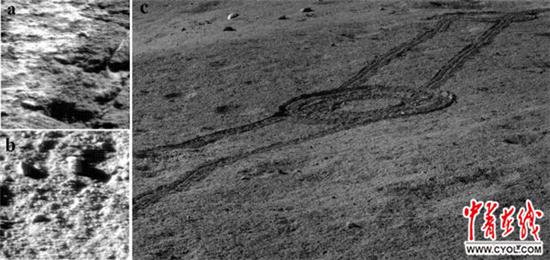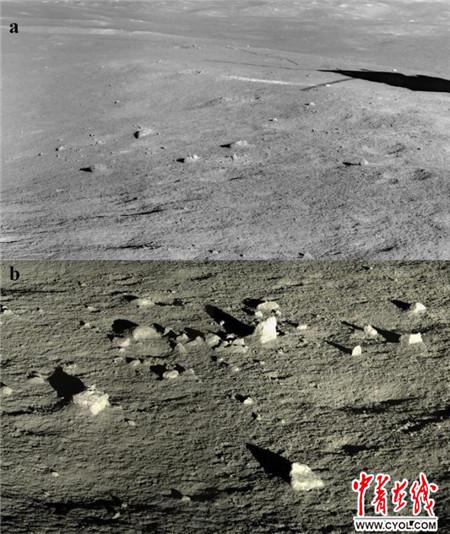https://news.sina.com.cn/c/2019-05-16/doc-ihvhiqax9123871.shtml
嫦娥四号在月背发现了这个 美苏探月都没能做到
2019年05月16日 15:44 中国青年报
0
原标题:嫦娥四号在月背发现了这个,美苏探月都没能做到
中青在线讯(中国青年报•中青在线记者 邱晨辉)备受瞩目的人类探测器首次月球背面之旅究竟有何新发现?5月16日,在嫦娥四号落月4个多月后,中国科学院国家天文台宣布,由该台研究员李春来领导的研究团队利用嫦娥四号探测数据,证明了月球背面南极-艾特肯盆地存在以橄榄石和低钙辉石为主的深部物质——而此前,人们并不确定月球深处究竟有什么。
北京时间5月16日凌晨,国际学术期刊《自然》(Nature)在线发布了这一重大发现。该发现为解答长期困扰国内外学者的有关月幔物质组成的问题提供了直接证据,将为完善月球形成与演化模型提供支撑。

 (嫦娥四号任务探测所获图像)
(嫦娥四号任务探测所获图像)
国际上有关月球早期演化的理论认为,月壳由是岩浆洋中较轻的斜长石组分上浮结晶形成,而如橄榄石、辉石等较重的矿物下沉形成月幔。然而,这一关于月幔组成的推论至今被没有很好地证实。
李春来说,一方面,美国阿波罗任务和苏联月球任务返回的月球样品中没有发现与月幔准确物质组成有关的直接证据。另一方面,最有可能撞穿月壳的月球背面南极-艾特肯盆地内,并未发现月幔指示矿物—橄榄石的大量出露的证据。“这是否说明富橄榄石的月幔假说是错误的?”
带着揭开月球深部物质成分神秘面纱的使命,来自中国的嫦娥四号探测器踏上了探索月球背面南极-艾特肯盆地,为月球起源演化研究提供新数据的征程。
2019年1月3日,嫦娥四号探测器着陆在月球背面预选着陆区冯卡门坑内。同一天,玉兔二号巡视器与着陆器分离,其上携带的红外成像光谱仪成功获取了着陆区两个探测点高质量光谱数据。
中科院国家天文台和仪器研制单位中科院上海技术物理所组成的研究团队通过对光谱数据的分析发现,嫦娥四号着陆区月壤光谱的吸收特征与月球正面月海玄武岩质月壤光谱的吸收特征存在着显著差异,展现出低钙辉石的光谱特征,并暗示有大量橄榄石的存在。进一步的分析证实,嫦娥四号着陆区月壤物质中橄榄石相对含量最高,低钙辉石次之,仅含有很少量的高钙辉石。这种矿物组合很可能代表了源于月幔的深部物质。
值得注意的是,嫦娥四号探测器的着陆点位于南极-艾特肯盆地内的冯•卡门撞击坑内部,早期研究结果表明其表面被后续喷发的玄武岩所填充,那么这些不同于玄武岩的深部物质,又是如何分布在着陆区域内的?
对覆盖着陆区域的高分辨率遥感图像数据和高光谱数据的分析结果显示,着陆器和月球车位于玄武岩“平原”的撞击溅射物上,这些溅射物来自东北方向的芬森撞击坑。
李春来说,40多亿年前南极-艾特肯盆地形成时已将月壳减薄或完全剥离。芬森坑是由小天体撞击南极-艾特肯盆地内部表面而形成,其犹如在南极-艾特肯盆地表面打的一口“深钻”一般,进一步将南极-艾特肯盆地表面以下月球更深部物质挖掘出,产生的溅射物四处抛射,呈辐射线撒布在冯卡门撞击坑“平原”上。因此,嫦娥四号红外成像光谱仪分析到的对象,正是芬森撞击坑挖掘、抛射到冯•卡门撞击坑表面的月幔物质。
来自中科院国家天文台的消息称,嫦娥四号探测器实现了人类历史上首次对月球背面的软着陆就位探测,而此次基于探测数据的研究结果,则成功揭示了月球背面的物质组成,证实了月幔富含橄榄石的推论的正确性,加深了人类对月球形成与演化的认识。
(教育科学部编辑)
On the 4th, I found this in the back of the moon.
May 16th, 2019 15:44 China Youth Daily
0
Original title: 嫦娥4 found this on the back of the moon, and the US and the Soviet Union failed to do it.
Zhongqing Online News (China Youth Daily • Zhongqing Online Journalist Qiu Chenhui) What are the new discoveries of the highly anticipated human detector on the back of the moon? On May 16th, more than four months after the Lunar New Year's Eve, the National Astronomical Observatory of the Chinese Academy of Sciences announced that the research team led by the researcher Li Chunlai used the No. 4 probe data to prove the back of the Moon to the Antarctic-Aitken Basin. There are deep matter dominated by olivine and low-lime pyroxene – and it was not certain that there was anything in the depths of the moon.
On the morning of May 16th, Beijing time, the international academic journal Nature released this major discovery online. This finding provides direct evidence for answering questions about the composition of the lunar sputum that have long plagued domestic and foreign scholars, and will provide support for improving the lunar formation and evolution model.
(嫦娥4 Mission Detection Image) (嫦娥4 Mission Detection Image)
The international theory of the early evolution of the moon suggests that the moon shell is formed by the floating crystals of the lighter plagioclase components in the magma ocean, while the heavier minerals such as olivine and pyroxene sink to form the moon. However, this inference about the composition of the New Moon has not been well proven.
Li Chun said that on the one hand, there was no direct evidence related to the accurate material composition of the New Moon in the lunar samples returned by the American Apollo mission and the Soviet Moon mission. On the other hand, in the Antarctic-Aitken Basin, which is most likely to hit the lunar surface of the moon, there is no evidence of a large amount of exposure of the moonstone indicating mineral-olivine. “Does this mean that the peridot hypothesis of the peridot is wrong?”
With the mission of uncovering the mysterious veil of the deep material components of the moon, the 嫦娥4 detector from China embarked on a journey to explore the lunar back of the Antarctic-Aitken Basin, providing new data for the evolution of the origin of the moon.
On January 3, 2019, the No. 4 detector landed on the back of the moon and pre-selected the landing area of Fengkamen. On the same day, the Yutu No. 2 patrol was separated from the lander, and the infrared imaging spectrometer carried on it successfully acquired high-quality spectral data of two detection points in the landing zone.
The research team composed of the Shanghai Institute of Technical Physics of the Chinese Academy of Sciences, National Astronomical Observatory and Instrument Development Institute of the Chinese Academy of Sciences found that the absorption characteristics of the lunar soil spectrum in the landing area of the Chang'e-4 and the absorption characteristics of the lunar basaltic basalt lunar soil spectrum of the lunar surface exist. Significant differences show the spectral characteristics of low-calcium pyroxene and suggest the presence of large amounts of olivine. Further analysis confirmed that the relative content of olivine in the lunar soil of the No. 4 landing area was the highest, followed by low-calcium pyroxene, which contained only a small amount of high-calcium pyroxene. This mineral combination is likely to represent a deep matter originating from the New Moon.
It is worth noting that the landing point of the No. 4 detector is located inside the von Carmen crater in the Antarctic-Aitken Basin. Early research indicates that the surface is filled with basalt that is subsequently erupted, so these are different from the deep part of basalt. How is matter distributed in the landing zone?
The analysis of high-resolution remote sensing image data and hyperspectral data covering the landing area shows that the lander and lunar rover are located on the impact spatter of the basalt "plain" from the northeastern Finsen crater.
Li Chun said that the moon shell has been thinned or completely stripped when the Antarctic-Aitken Basin was formed more than 4 billion years ago. The Finsen pit is formed by a small celestial body striking the inner surface of the Antarctic-Aitken Basin. It is like a “deep drill” on the surface of the Antarctic-Aitken Basin, further deepening the moon below the surface of the Antarctic-Aitken Basin. The material was excavated, and the sputtered material was thrown at four places and radiated on the "plain" of the von Karman crater. Therefore, the object analyzed by the No. 4 infrared imaging spectrometer is the lunar material that was excavated by the Finson crater and projected onto the surface of the von Carmen crater.
According to the National Astronomical Observatory of the Chinese Academy of Sciences, the No. 4 detector realized the first soft landing of the lunar surface in human history, and the results of the research based on the detection data successfully revealed the material composition on the back of the moon. The correctness of the inscriptions of the Moonstone rich in olivine has deepened human understanding of the formation and evolution of the moon.
(Editor of the Ministry of Education Science)
嫦娥四号在月背发现了这个 美苏探月都没能做到
2019年05月16日 15:44 中国青年报
0
原标题:嫦娥四号在月背发现了这个,美苏探月都没能做到
中青在线讯(中国青年报•中青在线记者 邱晨辉)备受瞩目的人类探测器首次月球背面之旅究竟有何新发现?5月16日,在嫦娥四号落月4个多月后,中国科学院国家天文台宣布,由该台研究员李春来领导的研究团队利用嫦娥四号探测数据,证明了月球背面南极-艾特肯盆地存在以橄榄石和低钙辉石为主的深部物质——而此前,人们并不确定月球深处究竟有什么。
北京时间5月16日凌晨,国际学术期刊《自然》(Nature)在线发布了这一重大发现。该发现为解答长期困扰国内外学者的有关月幔物质组成的问题提供了直接证据,将为完善月球形成与演化模型提供支撑。


国际上有关月球早期演化的理论认为,月壳由是岩浆洋中较轻的斜长石组分上浮结晶形成,而如橄榄石、辉石等较重的矿物下沉形成月幔。然而,这一关于月幔组成的推论至今被没有很好地证实。
李春来说,一方面,美国阿波罗任务和苏联月球任务返回的月球样品中没有发现与月幔准确物质组成有关的直接证据。另一方面,最有可能撞穿月壳的月球背面南极-艾特肯盆地内,并未发现月幔指示矿物—橄榄石的大量出露的证据。“这是否说明富橄榄石的月幔假说是错误的?”
带着揭开月球深部物质成分神秘面纱的使命,来自中国的嫦娥四号探测器踏上了探索月球背面南极-艾特肯盆地,为月球起源演化研究提供新数据的征程。
2019年1月3日,嫦娥四号探测器着陆在月球背面预选着陆区冯卡门坑内。同一天,玉兔二号巡视器与着陆器分离,其上携带的红外成像光谱仪成功获取了着陆区两个探测点高质量光谱数据。
中科院国家天文台和仪器研制单位中科院上海技术物理所组成的研究团队通过对光谱数据的分析发现,嫦娥四号着陆区月壤光谱的吸收特征与月球正面月海玄武岩质月壤光谱的吸收特征存在着显著差异,展现出低钙辉石的光谱特征,并暗示有大量橄榄石的存在。进一步的分析证实,嫦娥四号着陆区月壤物质中橄榄石相对含量最高,低钙辉石次之,仅含有很少量的高钙辉石。这种矿物组合很可能代表了源于月幔的深部物质。
值得注意的是,嫦娥四号探测器的着陆点位于南极-艾特肯盆地内的冯•卡门撞击坑内部,早期研究结果表明其表面被后续喷发的玄武岩所填充,那么这些不同于玄武岩的深部物质,又是如何分布在着陆区域内的?
对覆盖着陆区域的高分辨率遥感图像数据和高光谱数据的分析结果显示,着陆器和月球车位于玄武岩“平原”的撞击溅射物上,这些溅射物来自东北方向的芬森撞击坑。
李春来说,40多亿年前南极-艾特肯盆地形成时已将月壳减薄或完全剥离。芬森坑是由小天体撞击南极-艾特肯盆地内部表面而形成,其犹如在南极-艾特肯盆地表面打的一口“深钻”一般,进一步将南极-艾特肯盆地表面以下月球更深部物质挖掘出,产生的溅射物四处抛射,呈辐射线撒布在冯卡门撞击坑“平原”上。因此,嫦娥四号红外成像光谱仪分析到的对象,正是芬森撞击坑挖掘、抛射到冯•卡门撞击坑表面的月幔物质。
来自中科院国家天文台的消息称,嫦娥四号探测器实现了人类历史上首次对月球背面的软着陆就位探测,而此次基于探测数据的研究结果,则成功揭示了月球背面的物质组成,证实了月幔富含橄榄石的推论的正确性,加深了人类对月球形成与演化的认识。
(教育科学部编辑)
On the 4th, I found this in the back of the moon.
May 16th, 2019 15:44 China Youth Daily
0
Original title: 嫦娥4 found this on the back of the moon, and the US and the Soviet Union failed to do it.
Zhongqing Online News (China Youth Daily • Zhongqing Online Journalist Qiu Chenhui) What are the new discoveries of the highly anticipated human detector on the back of the moon? On May 16th, more than four months after the Lunar New Year's Eve, the National Astronomical Observatory of the Chinese Academy of Sciences announced that the research team led by the researcher Li Chunlai used the No. 4 probe data to prove the back of the Moon to the Antarctic-Aitken Basin. There are deep matter dominated by olivine and low-lime pyroxene – and it was not certain that there was anything in the depths of the moon.
On the morning of May 16th, Beijing time, the international academic journal Nature released this major discovery online. This finding provides direct evidence for answering questions about the composition of the lunar sputum that have long plagued domestic and foreign scholars, and will provide support for improving the lunar formation and evolution model.
(嫦娥4 Mission Detection Image) (嫦娥4 Mission Detection Image)
The international theory of the early evolution of the moon suggests that the moon shell is formed by the floating crystals of the lighter plagioclase components in the magma ocean, while the heavier minerals such as olivine and pyroxene sink to form the moon. However, this inference about the composition of the New Moon has not been well proven.
Li Chun said that on the one hand, there was no direct evidence related to the accurate material composition of the New Moon in the lunar samples returned by the American Apollo mission and the Soviet Moon mission. On the other hand, in the Antarctic-Aitken Basin, which is most likely to hit the lunar surface of the moon, there is no evidence of a large amount of exposure of the moonstone indicating mineral-olivine. “Does this mean that the peridot hypothesis of the peridot is wrong?”
With the mission of uncovering the mysterious veil of the deep material components of the moon, the 嫦娥4 detector from China embarked on a journey to explore the lunar back of the Antarctic-Aitken Basin, providing new data for the evolution of the origin of the moon.
On January 3, 2019, the No. 4 detector landed on the back of the moon and pre-selected the landing area of Fengkamen. On the same day, the Yutu No. 2 patrol was separated from the lander, and the infrared imaging spectrometer carried on it successfully acquired high-quality spectral data of two detection points in the landing zone.
The research team composed of the Shanghai Institute of Technical Physics of the Chinese Academy of Sciences, National Astronomical Observatory and Instrument Development Institute of the Chinese Academy of Sciences found that the absorption characteristics of the lunar soil spectrum in the landing area of the Chang'e-4 and the absorption characteristics of the lunar basaltic basalt lunar soil spectrum of the lunar surface exist. Significant differences show the spectral characteristics of low-calcium pyroxene and suggest the presence of large amounts of olivine. Further analysis confirmed that the relative content of olivine in the lunar soil of the No. 4 landing area was the highest, followed by low-calcium pyroxene, which contained only a small amount of high-calcium pyroxene. This mineral combination is likely to represent a deep matter originating from the New Moon.
It is worth noting that the landing point of the No. 4 detector is located inside the von Carmen crater in the Antarctic-Aitken Basin. Early research indicates that the surface is filled with basalt that is subsequently erupted, so these are different from the deep part of basalt. How is matter distributed in the landing zone?
The analysis of high-resolution remote sensing image data and hyperspectral data covering the landing area shows that the lander and lunar rover are located on the impact spatter of the basalt "plain" from the northeastern Finsen crater.
Li Chun said that the moon shell has been thinned or completely stripped when the Antarctic-Aitken Basin was formed more than 4 billion years ago. The Finsen pit is formed by a small celestial body striking the inner surface of the Antarctic-Aitken Basin. It is like a “deep drill” on the surface of the Antarctic-Aitken Basin, further deepening the moon below the surface of the Antarctic-Aitken Basin. The material was excavated, and the sputtered material was thrown at four places and radiated on the "plain" of the von Karman crater. Therefore, the object analyzed by the No. 4 infrared imaging spectrometer is the lunar material that was excavated by the Finson crater and projected onto the surface of the von Carmen crater.
According to the National Astronomical Observatory of the Chinese Academy of Sciences, the No. 4 detector realized the first soft landing of the lunar surface in human history, and the results of the research based on the detection data successfully revealed the material composition on the back of the moon. The correctness of the inscriptions of the Moonstone rich in olivine has deepened human understanding of the formation and evolution of the moon.
(Editor of the Ministry of Education Science)
